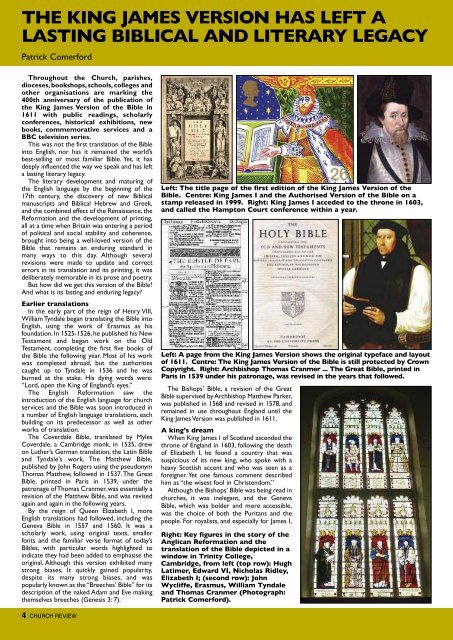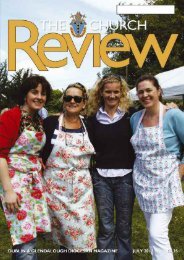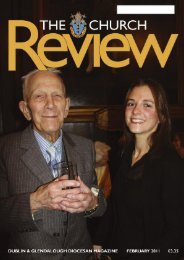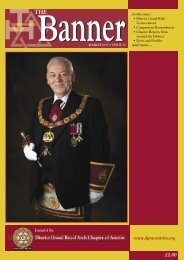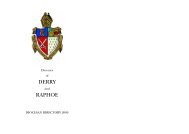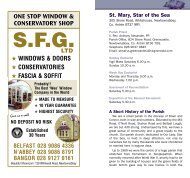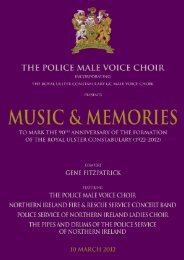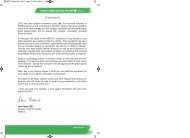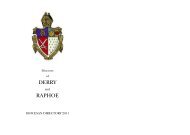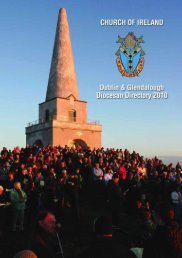church review
church review
church review
Create successful ePaper yourself
Turn your PDF publications into a flip-book with our unique Google optimized e-Paper software.
the KInG JaMes VersIon has left a<br />
lastInG bIblICal and lIterary leGaCy<br />
Patrick Comerford<br />
Throughout the Church, parishes,<br />
dioceses, bookshops, schools, colleges and<br />
other organisations are marking the<br />
400th anniversary of the publication of<br />
the King James Version of the Bible in<br />
1611 with public readings, scholarly<br />
conferences, historical exhibitions, new<br />
books, commemorative services and a<br />
BBC television series.<br />
This was not the first translation of the Bible<br />
into English, nor has it remained the world’s<br />
best-selling or most familiar Bible. Yet, it has<br />
deeply influenced the way we speak and has left<br />
a lasting literary legacy.<br />
The literary development and maturing of<br />
the English language by the beginning of the<br />
17th century, the discovery of new Biblical<br />
manuscripts and Biblical Hebrew and Greek,<br />
and the combined effect of the Renaissance, the<br />
Reformation and the development of printing,<br />
all at a time when Britain was entering a period<br />
of political and social stability and coherence,<br />
brought into being a well-loved version of the<br />
Bible that remains an enduring standard in<br />
many ways to this day. Although several<br />
revisions were made to update and correct<br />
errors in its translation and its printing, it was<br />
deliberately memorable in its prose and poetry.<br />
But how did we get this version of the Bible?<br />
And what is its lasting and enduring legacy?<br />
earlier translations<br />
In the early part of the reign of Henry VIII,<br />
William Tyndale began translating the Bible into<br />
English, using the work of Erasmus as his<br />
foundation. In 1525-1526, he published his New<br />
Testament and began work on the Old<br />
Testament, completing the first five books of<br />
the Bible the following year. Most of his work<br />
was completed abroad, but the authorities<br />
caught up to Tyndale in 1536 and he was<br />
burned at the stake. His dying words were:<br />
“Lord, open the King of England’s eyes.”<br />
The English Reformation saw the<br />
introduction of the English language for <strong>church</strong><br />
services and the Bible was soon introduced in<br />
a number of English language translations, each<br />
building on its predecessor as well as other<br />
works of translation.<br />
The Coverdale Bible, translated by Myles<br />
Coverdale, a Cambridge monk, in 1535, drew<br />
on Luther’s German translation, the Latin Bible<br />
and Tyndale’s work. The Matthew Bible,<br />
published by John Rogers using the pseudonym<br />
Thomas Matthew, followed in 1537. The Great<br />
Bible, printed in Paris in 1539, under the<br />
patronage of Thomas Cranmer, was essentially a<br />
revision of the Matthew Bible, and was revised<br />
again and again in the following years.<br />
By the reign of Queen Elizabeth I, more<br />
English translations had followed, including the<br />
Geneva Bible in 1557 and 1560. It was a<br />
scholarly work, using original texts, smaller<br />
fonts and the familiar verse format of today’s<br />
Bibles, with particular words highlighted to<br />
indicate they had been added to emphasise the<br />
original. Although this version exhibited many<br />
strong biases, It quickly gained popularity,<br />
despite its many strong biases, and was<br />
popularly known as the “Breeches’ Bible” for its<br />
description of the naked Adam and Eve making<br />
themselves breeches (Genesis 3: 7).<br />
left: the title page of the first edition of the King James Version of the<br />
bible. Centre: King James I and the authorised Version of the bible on a<br />
stamp released in 1999. right: King James I acceded to the throne in 1603,<br />
and called the hampton Court conference within a year.<br />
left: a page from the King James Version shows the original typeface and layout<br />
of 1611. Centre: the King James Version of the bible is still protected by Crown<br />
Copyright. right: archbishop thomas Cranmer ... the Great bible, printed in<br />
Paris in 1539 under his patronage, was revised in the years that followed.<br />
The Bishops’ Bible, a revision of the Great<br />
Bible supervised by Archbishop Matthew Parker,<br />
was published in 1568 and revised in 1578, and<br />
remained in use throughout England until the<br />
King James Version was published in 1611.<br />
a king’s dream<br />
When King James I of Scotland ascended the<br />
throne of England in 1603, following the death<br />
of Elizabeth I, he found a country that was<br />
suspicious of its new king, who spoke with a<br />
heavy Scottish accent and who was seen as a<br />
foreigner. Yet one famous comment described<br />
him as “the wisest fool in Christendom.”<br />
Although the Bishops’ Bible was being read in<br />
<strong>church</strong>es, it was inelegant, and the Geneva<br />
Bible, which was bolder and more accessible,<br />
was the choice of both the Puritans and the<br />
people. For royalists, and especially for James I,<br />
right: Key figures in the story of the<br />
anglican reformation and the<br />
translation of the bible depicted in a<br />
window in trinity College,<br />
Cambridge, from left (top row): hugh<br />
latimer, edward VI, nicholas ridley,<br />
elizabeth I; (second row): John<br />
Wycliffe, erasmus, William tyndale<br />
and thomas Cranmer (Photograph:<br />
Patrick Comerford).<br />
4 ChurCh <strong>review</strong>


